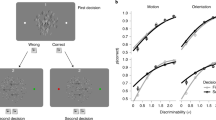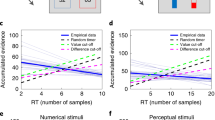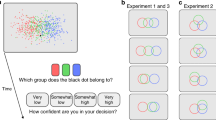Abstract
Decisions vary in difficulty. Humans know this and typically report more confidence in easy than in difficult decisions. However, confidence reports do not perfectly track decision accuracy, but also reflect response biases and difficulty misjudgements. To isolate the quality of confidence reports, we developed a model of the decision-making process underlying choice-confidence data. In this model, confidence reflects a subject’s estimate of the reliability of their decision. The quality of this estimate is limited by the subject’s uncertainty about the uncertainty of the variable that informs their decision (‘meta-uncertainty’). This model provides an accurate account of choice-confidence data across a broad range of perceptual and cognitive tasks, investigated in six previous studies. We find meta-uncertainty varies across subjects, is stable over time, generalizes across some domains and can be manipulated experimentally. The model offers a parsimonious explanation for the computational processes that underlie and constrain the sense of confidence.
This is a preview of subscription content, access via your institution
Access options
Access Nature and 54 other Nature Portfolio journals
Get Nature+, our best-value online-access subscription
$29.99 / 30 days
cancel any time
Subscribe to this journal
Receive 12 digital issues and online access to articles
$119.00 per year
only $9.92 per issue
Buy this article
- Purchase on Springer Link
- Instant access to full article PDF
Prices may be subject to local taxes which are calculated during checkout






Similar content being viewed by others
Data availability
This study generated no new data. The data used in this study are available from the Confidence Database (available at: https://osf.io/s46pr/).
Code availability
The code supporting the findings of this study and a software package implementing the CASANDRE model is publicly available (https://github.com/gorislab/CASANDRE.git).
References
Meyniel, F., Sigman, M. & Mainen, Z. F. Confidence as Bayesian probability: from neural origins to behavior. Neuron 88, 78–92 (2015).
Drugowitsch, J., Mendonça, A. G., Mainen, Z. F. & Pouget, A. Learning optimal decisions with confidence. Proc. Natl Acad. Sci. USA 116, 24872–24880 (2019).
Purcell, B. A. & Kiani, R. Hierarchical decision processes that operate over distinct timescales underlie choice and changes in strategy. Proc. Natl Acad. Sci. USA 113, E4531–E4540 (2016).
Bahador, B. et al. Optimally interacting minds. Science 329, 1081–1085 (2010).
Peirce, C. S. & Jastrow, J. On small differences in sensation. Memoirs of the National Academy of Sciences, 3, 75–83 (1884).
Ratcliff, R. A theory of memory retrieval. Psychol. Rev. 85, 59–108 (1978).
Vickers, D. Decision processes in visual perception. (Academic, 1979).
de Gardelle, V., Le Corre, F. & Mamassian, P. Confidence as a common currency between vision and audition. PLoS ONE 11, e0147901 (2016).
Fleming, S. M., Weil, R. S., Nagy, Z. Dolan, R. J. & Rees, G. Relating introspective accuracy to individual differences in brain structure. Science 329, 1541–1543 (2010).
Rouault, M., Seow, T., Gillan, C. M. & Fleming, S. M. Psychiatric symptom dimensions are associated with dissociable shifts in metacognition but not task performance. Biol. Psychiatry 84, 443–451 (2018).
Kuhn, D. in Children’s Reasoning and the Mind (eds Mitchell, P. & Riggs, K. J.) 301–326 (Psychology Press, 2000).
Nelson, T. O. A comparison of current measures of the accuracy of feeling-of-knowing predictions. Psychol. Bull. 95, 109–133 (1984).
Fleming, S. M. & Lau, H. C. How to measure metacognition. Front. Hum. Neurosci. 8, 443 (2014).
Mamassian, P. Visual confidence. Annu. Rev. Vis. Sci. 2, 459–481 (2016).
Guggenmos, M. Measuring metacognitive performance: type 1 performance dependence and test-retest reliability. Neurosci. Conscious. 2021, niab040 (2021).
Festinger, L. Studies in decision: I. Decision-time, relative frequency of judgment and subjective confidence as related to physical stimulus difference. J. Exp. Psychol. 32, 291–306 (1943).
Hosseini, J. & Ferrell, W. R. Detectability of correctness: a measure of knowing that one knows. Instructional Sci. 11, 113–127 (1982).
Critchfield, T. S. Signal-detection properties of verbal self-reports. J. Exp. Anal. Behav. 60, 495–514 (1993).
Galvin, S. J., Podd, J. V., Drga, V. & Whitmore, J. Type 2 tasks in the theory of signal detectability: discrimination between correct and incorrect decisions. Psychon. Bull. Rev. 10, 843–876 (2003).
Maniscalco, B. & Lau, H. A signal detection theoretic approach for estimating metacognitive sensitivity from confidence ratings. Conscious. Cogn. 21, 422–430 (2012).
Fleming, S. M. & Daw, N. D. Self-evaluation of decision-making: a general Bayesian framework for metacognitive computation. Psychol. Rev. 124, 91–114 (2017).
Adler, W. T. & Ma, W. J. Comparing Bayesian and non-Bayesian accounts of human confidence reports. PLoS Comput. Biol. 14, e1006572 (2018).
Bang, J. W., Shekhar, M. & Rahnev, D. Sensory noise increases metacognitive efficiency. J. Exp. Psychol. Gen. 148, 437–452 (2019).
Khalvati, K., Kiani, R. & Rao, R. P. N. Bayesian inference with incomplete knowledge explains perceptual confidence and its deviations from accuracy. Nat. Commun. 12, 5704 (2021).
Shekhar, M. & Rahnev, D. The nature of metacognitive inefficiency in perceptual decision making. Psychol. Rev. 128, 45–70 (2021).
Mamassian, P. & de Gardelle, V. Modeling perceptual confidence and the confidence forced-choice paradigm. Psychol. Rev. https://doi.org/10.1037/rev0000312 (2021).
Caziot, B. & Mamassian, P. Perceptual confidence judgments reflect self-consistency. J. Vis. 21, 8 (2021).
Pouget, A., Drugowitsch, J. & Kepecs, A. Confidence and certainty: distinct probabilistic quantities for different goals. Nat. Neurosci. 19, 366–374 (2016).
Green, D. M. & Swets, J. A. Signal Detection Theory and Psychophysics, Vol. 1 (Wiley, 1966).
Koriat, A. The self-consistency model of subjective confidence. Psychol. Rev. 119, 80–113 (2012).
Rahnev, D. et al. The confidence database. Nat. Hum. Behav. 4, 317–325 (2020).
Navajas, J. et al. The idiosyncratic nature of confidence. Nat. Hum. Behav. 1, 810–818 (2017).
Denison, R. N., Adler, W. T., Carrasco, M. & Ma, W. J. Humans incorporate attention-dependent uncertainty into perceptual decisions and confidence. Proc. Natl Acad. Sci. USA 115, 11090–11095 (2018).
Rausch, M., Zehetleitner, M., Steinhauser, M. & Maier, M. E. Cognitive modelling reveals distinct electrophysiological markers of decision confidence and error monitoring. NeuroImage 218, 116963 (2020).
Balakrishnan, J. D. & Ratcliff, R. Testing models of decision making using confidence ratings in classification. J. Exp. Psychol. Hum. Percept. Perform. 22, 615–633 (1996).
Ferrell, W. R. A model for realism of confidence judgments: implications for underconfidence in sensory discrimination. Percept. Psychophys. 57, 246–254 (1995).
Kepecs, A., Uchida, N., Zariwala, H. A. & Zachary, Z. F. Neural correlates, computation and behavioural impact of decision confidence. Nature 455, 227–231 (2008).
Treisman, M. & Faulkner, A. The setting and maintenance of criteria representing levels of confidence. J. Exp. Psychol. Hum. Percept. Perform. 10, 119–139 (1984).
Wallsten, T. S. & González-Vallejo, C. Statement verification: a stochastic model of judgment and response. Psychol. Rev. 101, 490–504 (1994).
Jaynes, E. T. Information theory and statistical mechanics. Phys. Rev. 106, 620–630 (1957).
Mahajan, S. Street-Fighting Mathematics: The Art of Educated Guessing and Opportunistic Problem Solving (MIT Press, 2010).
Locke, S. M., Gaffin-Cahn, E., Hosseinizaveh, N., Mamassian, P. & Landy, M. S. Priors and payoffs in confidence judgments. Atten. Percept. Psychophys. 82, 3158–3175 (2020).
Mihali, A., Broeker, M. & Horga, G. Insightful inference compensates for distorted perception. Preprint at bioRxiv https://doi.org/10.1101/2021.11.13.468497 (2021).
Fetsch, C. R., Kiani, R., Newsome, W. T. & Shadlen, M. N. Effects of cortical microstimulation on confidence in a perceptual decision. Neuron 83, 797–804 (2014).
Fetsch, C. R. et al. Focal optogenetic suppression in macaque area MT biases direction discrimination and decision confidence, but only transiently. eLife 7(July), e36523 (2018).
Xue, K., Shekhar, M. & Rahnev, D. Examining the robustness of the relationship between metacognitive efficiency and metacognitive bias. Conscious. Cogn. 95, 103196 (2021).
McCurdy, L. Y. et al. Anatomical coupling between distinct metacognitive systems for memory and visual perception. J. Neurosci. 33, 1897–1906 (2013).
Baird, B., Cieslak, M., Smallwood, J., Grafton, S. T. & Schooler, J. W. Regional white matter variation associated with domain-specific metacognitive accuracy. J. Cogn. Neurosci. 27, 440–452 (2015).
Lee, A. L. F., Ruby, E., Giles, N. & Lau, H. Cross-domain association in metacognitive efficiency depends on first-order task types. Front. Psychol. 9, 2464 (2018).
Shields, W. E., Smith, J. D., Guttmannova, K. & Washburn, D. A. Confidence judgments by humans and rhesus monkeys. J. Gen. Psychol. 132, 165–186 (2005).
Locke, S. M., Landy, M. S. & Mamassian, P. Suprathreshold perceptual decisions constrain models of confidence. PLoS Comput. Biol. 18, e1010318 (2022).
Rahnev, D. et al. Consensus goals in the field of visual metacognition. Perspect. Psychol. Sci. https://doi.org/10.1177/17456916221075615 (2022).
Ko, Y. & Lau, H. A detection theoretic explanation of blindsight suggests a link between conscious perception and metacognition. Philos. Trans. R. Soc. Lond. B Biol. Sci. 367, 1401–1411 (2012).
Komura, Y., Nikkuni, A., Hirashima, N., Uetake, T. & Miyamoto, A. Responses of pulvinar neurons reflect a subject’s confidence in visual categorization. Nat. Neurosci. 16, 749–755 (2013).
Massoni, S., Gajdos, T. & Vergnaud, J.-C. Confidence measurement in the light of signal detection theory. Front. Psychol. 5, 1455 (2014).
Zylberberg, A., Barttfeld, P. & Sigman, M. The construction of confidence in a perceptual decision. Front. Integr. Neurosci. 6, 79 (2012).
Maniscalco, B., Peters, M. A. K. & Lau, H. Heuristic use of perceptual evidence leads to dissociation between performance and metacognitive sensitivity. Atten. Percept. Psychophys. 78, 923–937 (2016).
Peters, M. A. K. et al. Perceptual confidence neglects decision-incongruent evidence in the brain. Nat. Hum. Behav. 1, 1–8 (2017).
Fetsch, C. R., Kiani, R. & Shadlen, M. N. Predicting the accuracy of a decision: a neural mechanism of confidence. Cold Spring Harb. Symp. Quant. Biol. 79, 185–197 (2014).
Murphy, P. R., Robertson, I. H., Harty, S. & O’Connell, R. G. Neural evidence accumulation persists after choice to inform metacognitive judgments. eLife 4, e11946 (2015).
Maniscalco, B. & Lau, H. The signal processing architecture underlying subjective reports of sensory awareness. Neurosci. Conscious. 2016, niw002 (2016).
Lak, A. et al. Orbitofrontal cortex is required for optimal waiting based on decision confidence. Neuron 84, 190–201 (2014).
Kiani, R. & Shadlen, M. N. Representation of confidence associated with a decision by neurons in the parietal cortex. Science 324, 759–764 (2009).
Sanders, J. I., Hangya, B. & Kepecs, A. Signatures of a statistical computation in the human sense of confidence. Neuron 90, 499–506 (2016).
Hangya, B., Sanders, J. I. & Kepecs, A. A mathematical framework for statistical decision confidence. Neural Comput. 28, 1840–1858 (2016).
Adler, W. T. & Ma, W. J. Limitations of proposed signatures of Bayesian confidence. Neural Comput. 30, 3327–3354 (2018).
Li, H.-H. & Ma, W. J. Confidence reports in decision-making with multiple alternatives violate the Bayesian confidence hypothesis. Nat. Commun. 11, 2004 (2020).
Geurts, L. S., Cooke, J. R. H., van Bergen, R. S. & Jehee, J. F. M. Subjective confidence reflects representation of Bayesian probability in cortex. Nat. Hum. Behav. 6, 294–305 (2022).
De Martino, B., Fleming, S. M., Garrett, N. & Dolan, R. Confidence in value-based choice. Nat. Neurosci. 16, 105–110 (2013).
Ernst, M. O. & Banks, M. S. Humans integrate visual and haptic information in a statistically optimal fashion. Nature 415, 429 (2002).
Fetsch, C. R., Pouget, A., DeAngelis, G. C. & Angelaki, D. E. Neural correlates of reliability-based cue weighting during multisensory integration. Nat. Neurosci. 15, 146 (2012).
Qamar, A. T. et al. Trial-to-trial, uncertainty-based adjustment of decision boundaries in visual categorization. Proc. Natl Acad. Sci. USA 110, 20332–20337 (2013).
Ma, W. J., Beck, J. M., Latham, P. E. & Pouget, A. Bayesian inference with probabilistic population codes. Nat. Neurosci. 9, 1432 (2006).
Orban, G., Berkes, P., Fiser, J. & Lengyel, M. Neural variability and sampling-based probabilistic representations in the visual cortex. Neuron 92, 530–543 (2016).
van Bergen, R. S., Ji Ma, W., Pratte, M. S. & Jehee, J. F. M. Sensory uncertainty decoded from visual cortex predicts behavior. Nat. Neurosci. 18, 1728–1730 (2015).
Henaff, O. J., Boundy-Singer, Z. M., Meding, K., Ziemba, C. M. & Goris, R. L. T. Representation of visual uncertainty through neural gain variability. Nat. Commun. 11, 2513 (2020).
Walker, E. Y., Cotton, R. J., Ma, W. J. & Tolias, A. S. A neural basis of probabilistic computation in visual cortex. Nat. Neurosci. 23, 122–129 (2020).
Festa, D., Aschner, A., Davila, A., Kohn, A. & Coen-Cagli, R. Neuronal variability reflects probabilistic inference tuned to natural image statistics. Nat. Commun. 12, 3635 (2021).
Allen, M. et al. Unexpected arousal modulates the influence of sensory noise on confidence. eLife 5, e18103 (2016).
Maniscalco, B., McCurdy, L. Y., Odegaard, B. & Lau, H. Limited cognitive resources explain a trade-off between perceptual and metacognitive vigilance. J. Neurosci. 37, 1213–1224 (2017).
Rahnev, D., Koizumi, A., McCurdy, L. Y., D’Esposito, M. & Lau, H. Confidence leak in perceptual decision making. Psychol. Sci. 26, 1664–1680 (2015).
Fleming, S. M. Action-specific disruption of perceptual confidence. Psychol. Sci. 26, 89–98 (2015).
Palmer, J., Huk, A. C. & Shadlen, M. N. The effect of stimulus strength on the speed and accuracy of a perceptual decision. J. Vis. 5, 1 (2005).
Hanks, T. D., Mazurek, M. E., Kiani, R., Hopp, E. & Shadlen, M. N. Elapsed decision time affects the weighting of prior probability in a perceptual decision task. J. Neurosci. 31, 6339–6352 (2011).
Kiani, R., Corthell, L. & Shadlen, M. N. Choice certainty is informed by both evidence and decision time. Neuron 84, 1329–1342 (2014).
Zylberberg, A., Fetsch, C. R. & Shadlen, M. N. The influence of evidence volatility on choice, reaction time and confidence in a perceptual decision. eLife 5, e17688 (2016).
Geisler, W. S. in The Visual Neurosciences, Vol. 10 (eds Chalupa, L. & Werne, J.) 825–837 (MIT Press, 2003).
Weiss, Y., Simoncelli, E. P. & Adelson, E. H. Motion illusions as optimal percepts. Nat. Neurosci. 5, 598 (2002).
Persaud, N., McLeod, P. & Cowey, A. Post-decision wagering objectively measures awareness. Nat. Neurosci. 10, 257–261 (2007).
Dienes, Z. & Seth, A. Gambling on the unconscious: a comparison of wagering and confidence ratings as measures of awareness in an artificial grammar task. Conscious. Cogn. 19, 674–681 (2010).
Murad, Z., Sefton, M. & Starmer, C. How do risk attitudes affect measured confidence? J. Risk Uncertain. 52, 21–46 (2016).
Wichmann, F. A. & Hill, N. J. The psychometric function: I. Fitting, sampling, and goodness of fit. Percept. Psychophys. 63, 1293–1313 (2001).
Acknowledgements
We thank the creators and contributors to the Confidence Database and J. Navajas for making their data available. This work was supported by the US National Science Foundation (Graduate Research Fellowship to Z.M.B.-S.), the US National Institutes of Health (grant nos. T32 EY021462 and K99 EY032102 to C.M.Z., and EY032999 to R.L.T.G.), and the Whitehall Foundation (grant no. UTA19-000535 to R.L.T.G.). The funders had no role in the study design, data collection and analysis, decision to publish or preparation of the manuscript.
Author information
Authors and Affiliations
Contributions
Z.M.B.-S., C.M.Z. and R.L.T.G. conceived the study, developed the theory, performed the simulations, analysed the data, and wrote the paper.
Corresponding author
Ethics declarations
Competing interests
The authors declare no competing interests.
Peer review
Peer review information
Nature Human Behaviour thanks Dobromir Rahnev, Rachel Denison, and the other, anonymous, reviewer(s) for their contribution to the peer review of this work. Peer reviewer reports are available.
Additional information
Publisher’s note Springer Nature remains neutral with regard to jurisdictional claims in published maps and institutional affiliations.
Supplementary information
Rights and permissions
Springer Nature or its licensor (e.g. a society or other partner) holds exclusive rights to this article under a publishing agreement with the author(s) or other rightsholder(s); author self-archiving of the accepted manuscript version of this article is solely governed by the terms of such publishing agreement and applicable law.
About this article
Cite this article
Boundy-Singer, Z.M., Ziemba, C.M. & Goris, R.L.T. Confidence reflects a noisy decision reliability estimate. Nat Hum Behav 7, 142–154 (2023). https://doi.org/10.1038/s41562-022-01464-x
Received:
Accepted:
Published:
Issue Date:
DOI: https://doi.org/10.1038/s41562-022-01464-x
This article is cited by
-
Response sub-additivity and variability quenching in visual cortex
Nature Reviews Neuroscience (2024)
-
Introspective inference counteracts perceptual distortion
Nature Communications (2023)
-
Evaluating false positive rates of standard and hierarchical measures of metacognitive accuracy
Metacognition and Learning (2023)



